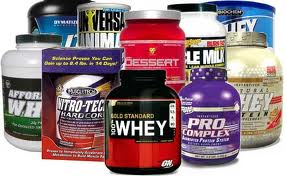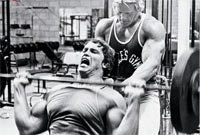- Like
- SHARE
- Digg
- Del
- Tumblr
- VKontakte
- Flattr
- Buffer
- Love This
- Save
- Odnoklassniki
- Meneame
- Blogger
- Amazon
- Yahoo Mail
- Gmail
- AOL
- Newsvine
- HackerNews
- Evernote
- MySpace
- Mail.ru
- Viadeo
- Line
- Comments
- Yummly
- SMS
- Viber
- Telegram
- JOIN
- Skype
- Facebook Messenger
- Kakao
- LiveJournal
- Yammer
- Edgar
- Fintel
- Mix
- Instapaper
- Copy Link
 Bodybuilding 101
Bodybuilding 101
By Julian Brown, BS, ACE-CPT, NASM-FNS
Have you ever thought about being a bodybuilder, but don’t really know where to start? Maybe you’re already further along than you think.
Bodybuilding by Definition
Bodybuilding by definition is the development of the body through diet and exercise. This classifies many exercisers as bodybuilders, but often the term bodybuilder means competitive bodybuilder in the exercise world. Typically, competitive bodybuilders are lean, muscular, and proportional because competitive bodybuilding involves evaluating muscularity (size), definition (leanness), symmetry, and presentation (posing). How do competitors get so muscular and lean?
Lifestyle
Being a competitive bodybuilder is a lifestyle commitment in certain aspects such as weight training and nutrition. Although, proper nutrition and weight training will improve your physique, it’s not going to happen overnight. Both of these tactics will need to be a staple in your lifestyle to help your successes as a competitive bodybuilder. For bodybuilding principles on nutrition and weight training check out bodybuilding nutrition 101 and weight training principles for bodybuilding.
Competition
Competitions have a few different elements to them the judging of the show, which involves pre-judging and individual routines, and the prepping for the show, which involves posing and tanning/oils. Hiring an experienced coach can help you perfect your posing, construct an individual routine, and make suggestions on posing trunks, tanning products, and oils so you don’t have to find out by trial and error. Also, I recommend seeing a competition before competing just so you’ll have an idea of what to expect.
- Pre-judging – In the pre-judging, competitors come on stage in groups and perform quarter turns (turning right), and eight mandatory poses the front double bicep, front lat spread, side chest pose, side tricep, rear double bicep, rear lat spread, abdominal and thigh pose, and the most muscular pose so the judges can assess the competitors muscularity (size), definition (leanness), symmetry, and presentation (posing) from various views and angles. Judges usually select the winners during the pre-judging aspect of the competition.
- Individual Routine – During the night show, competitors get the chance to display their physiques individually using a series of poses and music of their choosing. Some organizations allow props and costumes; however, they aren’t required. Best poser award generally goes to the competitor with the best individual posing routine.
- Posing – The ability to be able to present your physique in the best way possible is critical to bodybuilding. When you’re on stage, the judges are looking at all of you all the time not just when you’re posing. Practice posing and good posture endlessly during your contest preparation. Try developing techniques for each pose that can help you look your best and fully portray your physique.
- Tanning/Oil – Tanning is an excellent way to enhance the detail of your physique. Your natural skin complexion will play a role in the brand, type, and method of tanning you use so be sure to experiment beforehand, or hire a tanning expert that has experience in working with bodybuilders. Bright stage lights can washout your definition, but the right amount of posing oil can help highlight your physique under stage lighting. Most posing oils are acceptable as long as they are not overly applied. Going overboard won’t enhance your look, but instead make you too shiny for anyone to look at. A thin, evenly applied coat is all that is required.
This article may help you embark the start of a competitive bodybuilding career, or just realize you’re happy as an avid gym goer. Just remember, whether you’re a competitive bodybuilder or not it’s a lifestyle committed to developing the body through diet and exercise.
Demystifying the Key Elements of Bodybuilding
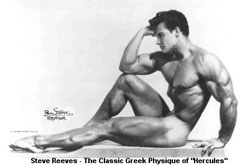 By Mate Radocaj
By Mate Radocaj
Building The Perfect Body
Demystifying the key elements of bodybuilding…
proportion and symmetry.
The “total package” everyone wants it, all admire it however many have no idea what it actually entails or how to achieve it.
The total package combines many elements but as it pertains to bodybuilding it can be narrowed down to proportion and symmetry. If you have proportion and symmetry than you have managed to achieve a basic work of art much like that of a chiseled Greek sculpture.
Perfectly Proportioned and Simply Symmetrical
What does it mean?…
Let me begin by saying that a perfectly proportioned and perfectly symmetrical physique is nearly impossible to achieve. Even the likes of Frank Zane, Steve Reeves, Bob Paris and Lee Labrada each legends know for their proportion and symmetry were not perfect. If they are not perfect than where does that leave you? Well, first of all as with so many other things your genetics will have a lot to do with how proportioned and symmetrical you can become. It is the ultimate predictor of how gifted you will be in these area and what many of the gifted have in common is good bone structure. If you have it than your golden or at the very least off to a good start. Now to break it down…
Proportion
When we talk about proportion we are looking at the body as a whole, it is the comparison of all body parts. A well proportioned body is esthetically pleasing to the eye…a pleasure to look at and certainly something to be proud of, for those who are fortunate enough to attain it.
To achieve proportion outside of genetics is a creative process. It is far more difficult than simply building muscle mass and requires an eye for muscular balance, extreme focus and smart, precise training techniques. A pitfall that many young bodybuilders fall victim to and one that is hard to rectify is the “beach body.” The beach body results from putting too much focus on the chest and arms, the parts primarily visible when at the beach. This is commonly accompanied by the question “how much can you bench?” Sound familiar? It is also the result of “chicken legs.” Legs that are underdeveloped in comparison to the upper body, definitely something you don’t want! Each muscle group must be worked equally to maintain the best possible proportion. Failure to do so results in a case of catch up which can be very frustrating and difficult to do. As for symmetry…
Symmetry
Symmetry and proportion work hand in hand and are very similar with symmetry being more precise. Symmetry is the comparison of muscle groups in size and shape on both the right and left sides of the body. Here you want to see that a specific muscle is equal on both sides as in the case of the right and left biceps. Is there a symmetry pitfall? Of course there is! An important aspect of keeping your muscles symmetrical is ensuring proper form when training. If your posture is off it will negatively affect how your muscle is worked, ultimately affecting your symmetry. Another thing to watch for is allowing a strong muscle to compensate for a weak one. When training it’s important to use the same weight for both sides of the body (for example the left arm and right arm) and to primarily use free weights and cables. The use of barbells and some machines can actually work against symmetry as often the body will naturally compensate the strong side for the weak. What is the ultimate goal?…
A physique that flows
Ultimately, your goal should be from the onset of training to develop a physique that flows. You want to create an illusion with muscles that are defined, have depth, fullness and shape. Perfect proportion and symmetry has been described as the body being in the form of an “X.” The top of the -X- representing wide shoulders, the upper center of the -X- being a wide back (lats,) the center of the -X- a small waist, the bottom of the -X- representing long legs with a wide quad sweep and the lower part of the -X- full, diamond shaped calves.
To sum it all up, mass, proportion and symmetry are an extremely difficult combination to achieve which is why so very few ever make it to the IFBB Pro ranks. That being said you can be your very best by constantly monitoring your physique, controlling your growth and development (thick, blocky over-developed muscles destroy shape) and by training wisely, with the choice of exercises you do (certain exercises develop different areas of the same muscle) you will be well on your way to building the perfect (or nearly perfect) body!
See Also:
Bodybuilding Nutrition 101
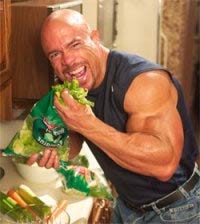 By Julian Brown, BS, ACE-CPT, NASM-FNS
By Julian Brown, BS, ACE-CPT, NASM-FNS
As a natural bodybuilder, I know proper nutrition is a key component to building a better physique.
I know this through personal experience and the results of my clients, but don’t just take my word for it. The American Dietetic Association, Dietitians of Canada, and the American College of Sports Medicine state that optimal nutrition will enhance physical activity, athletic performance and recovery from exercise1.
Without proper diet and nutrition, even with all the best training in the world, you’re still selling yourself short. You must meet energy and macronutrient needs, especially carbohydrate and protein, during times of high physical activity in order to replenish glycogen stores, and to provide adequate protein to build and repair tissue.
In this article, I’ll teach you how to improve your physique by following these basic bodybuilding nutrition principles.
Adequate Protein
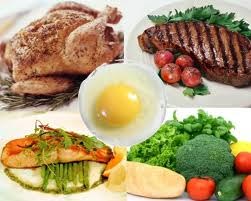
If you’re trying to build muscle, your body will need an adequate amount of protein. Protein builds and repair tissues and it has been documented that increased protein intake improves performance. Exactly how much protein do you need to meet your goals? The ADA, DOC and ACSM recommend that endurance and strength-trained athletes (bodybuilders) have between 1.2 and 1.7 g per kg of body weight (0.5 – 0.8 grams per pound) of protein for the best performance and health1. Therefore, any excess protein consumed isn’t going to improve your performance or strength gains.
However, does that mean you should never consume more than the recommended amount and does consuming too much protein damage your kidneys? Let us set the record straight on protein and your kidneys. When protein is metabolized by the body nitrogen is produced as a by-product. Thus, making kidneys work to remove the extra nitrogen from the body, but making the body work harder isn’t necessarily bad. A review of the scientific literature on protein intake and renal function found that “there is no reason to restrict protein in healthy individuals.” The study also concludes that a low protein intake did not prevent the decline in renal function with age, and it could actually be the cause of this decline2 (discussion about low protein and renal function seems out of place here.) Now that the record on protein is cleared up, let us discuss how it pertains to you.
Ideally, as a bodybuilder you should try to consume at least .8 grams of protein per lb bodyweight on a daily basis. That’s roughly 144 grams of protein for a 180lb person, but bodybuilders beware, not all protein sources are physique friendly. Not only are some animal protein sources high in saturated fat, which is a health concern, but the higher fat content means you’ll be consuming more calories as well. Consuming excess calories may lead to gaining the wrong kind of weight so try to stick to lean protein sources such as turkey, tuna, chicken breast, salmon, low fat dairy, lean beef, and egg whites.
Slow digesting Carbs
Carb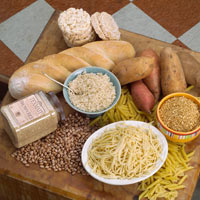 ohydrates have gotten a bad reputation over the years, but the truth is not all carbohydrates are created equal. The glycemic index or GI describes this difference by ranking carbohydrates according to their effect on our blood glucose levels. Refined/processed carbohydrates, found in products made with white flour, such as bread, pasta, muffins, donuts, cakes, and cookies are depleted of their naturally-occurring fibers. Because of this, these foods have a high glycemic index value, meaning they rapidly digest and enter the blood stream causing a spike in blood glucose levels3. In response, the pancreas releases insulin, which directs the cells to absorb the glucose. The more blood glucose the more insulin the pancreas releases.
ohydrates have gotten a bad reputation over the years, but the truth is not all carbohydrates are created equal. The glycemic index or GI describes this difference by ranking carbohydrates according to their effect on our blood glucose levels. Refined/processed carbohydrates, found in products made with white flour, such as bread, pasta, muffins, donuts, cakes, and cookies are depleted of their naturally-occurring fibers. Because of this, these foods have a high glycemic index value, meaning they rapidly digest and enter the blood stream causing a spike in blood glucose levels3. In response, the pancreas releases insulin, which directs the cells to absorb the glucose. The more blood glucose the more insulin the pancreas releases.
Unfortunately, insulin also promotes the storage of fat in the body if there’s excess glucose; which is why it is important to limit refined carbs and sugars. Sweet potatoes, oatmeal, bran cereal, brown rice, whole grains, beans, fruits, and vegetables are all examples of low GI foods, meaning they’re slower to digest and affect blood glucose levels less3; thus, increasing the likelihood of those carbs being used as energy instead of stored as fat. Plus, choosing carbs that digest slowly can help stave off hunger by making you feel fuller longer. Another benefit of low GI carbs is most of them contain fiber, vitamins, and minerals which provide a plethora of health benefits as well.
Healthy Fats
Fat doesn’t always have to be the enemy. Dietary fat is a vital part of any diet because fat helps supply our bodies with essential fatty acids (EFAs), provides energy, helps us absorb certain vitamins, helps us grow and supports a strong immune system. Also, according to research published in the Journal of Applied Physiology by a team of Penn State University researchers, a positive correlation exists between dietary fat and testosterone levels 4 and when it comes to building muscle testosterone is the king of hormones. Studies show that testosterone, especially when combined with strength training, increases fat-free mass and muscle size and strength5.
However, all this doesn’t mean you need to go on a high fat diet. Limit your intake of saturated and trans fats as they are thought to play a role in cardiovascular disease, obesity, and type 2 diabetes6. Try to stick to monounsaturated and polyunsaturated fats as such as olive oil, avocados, nuts, seeds, flaxseed, flax oil, walnuts and cold water fish like salmon as these fats have been associated with improved blood cholesterol levels6. So exactly how much fat do you need? The USDA recommends that only 20%-35% of your diet come from dietary fat as these ranges have been associated with a reduced risk of chronic diseases, and it provides adequate fat intake for essential nutrient absorption7.
Pre Workout Meal/Snack
Skipping out on your pre workout meal is a big no no. Providing your body with a pre workout meal or snack that is high in carbs, moderate in protein, low in fat, and sufficient in fluids will help your body maintain blood glucose concentrations during exercise, maximize exercise performance, improve recovery time, and maintain hydration. Everyone’s workout schedule is a little different so the size and timing of the meal should be interrelated. Consume smaller meals 30-60 minutes prior to exercising, and larger meals when more time is available before exercise.
However, most of us have heard the claim that exercising on an empty stomach burns more fat. Well, a study published in the International Journal of Sports Nutrition Exercise and Metabolism8 concluded that not only is the metabolism higher in the fed condition compared to the fasted condition, but that fat use is higher after exercise as well. Want to start burning more fat after your workout? Also, the study points out that after a pre-workout meal, not only is the metabolism high during the workout, but it stays at a high level for 112 hours after the workout. Start eating a pre workout meal.
Post Workout Meal/Snack
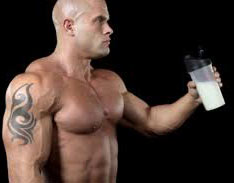
Weight training increases insulin sensitivity and glucose absorption, meaning it is easier for the body to absorb sugar from the bloodstream and store it in muscles and other tissues where it can be used as fuel to replenish glycogen stores and rebuild muscle tissue. After an intense training session, consuming carbs in conjunction with protein post workout provides more amino acids for muscle repair and promote a more anabolic (muscle building) hormonal profile1. Besides a protein shake, you can try chicken stir fry with brown rice, turkey/ tuna on whole wheat bread, egg white and spinach omelet, or even chocolate milk as a post workout meal or snack.
Implementation
How does this article benefit you if you don’t apply these nutrition tactics? It doesn’t. Just like you have to consistently lift weights over time to build muscle you have to consistently eat properly to achieve a better physique. ” Success is the sum of small efforts repeated day in and day out” (Collier,R) .
Julian Brown ACE CPT
Disclaimer: Before you begin any exercise program, and before you follow any of the advice, instructions, or any other recommendations in this article, you should first consult with your doctor and have a physical examination.
Bodybuilding Nutrition 101: References
1^ Position of the American Dietetic Association, Dietitians of Canada, and the American College of Sports Medicine: Nutrition and athletic performance. J Am Diet Assoc. 2009 Mar;109(3):509-27.
2^ Walser M. Effects of protein intake on renal function and on the development of renal disease. In: The Role of Protein and Amino Acids in Sustaining and Enhancing Performance. Committee on Military Nutrition Research, Institute of Medicine. Washington, DC: National Academies Press, 1999, pp. 137-154.
3^ Am. J. Clin. Nutr. Glycemic Index of Foods: a Physiological Basis for Carbohydrate Exchange. Jenkins DJ et al. 1981, 34: 3.
4^ Volek, J.S., Kraemer, W.J., Bush, J.A., Incledon, T., & Boetes, M. (1996). Testosterone and cortisol in relationship to dietary nutrients and resistance exercise. Journal of Applied Physiology, 82, 49-54
5^Bhasin S, Storer TW, Berman N, Callegari C, Clevenger B, Phillips J, Bunnell TJ, Tricker R, Shirazi A, Casaburi R (July 1996). “The effects of supraphysiologic doses of testosterone on muscle size and strength in normal men”. N. Engl. J. Med. 335 (1): 1–7.
6>^”Dietary Guidelines for Americans” . U.S. Department of Health and Human Services, U.S. Department of Agriculture. 2010. Retrieved 2011-09-27.
7^ “Dietary fats: Know which types to choose”. Mayo Clinic. 2011-02-15. Retrieved 2011-09-02.
8^ International Journal of Sports Nutrition Exercise and Metabolism (21:48-54, 2011)
Contest Dieting And Training Tips For Bodybuilders
By Julian Brown, BS, ACE-CPT, NASM-FNS
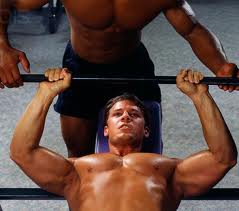 Bodybuilding Nutrition 101 discusses how to improve your physique through clean eating, but eating the right kinds of foods just isn’t enough when it comes to getting your physique stage ready.
Bodybuilding Nutrition 101 discusses how to improve your physique through clean eating, but eating the right kinds of foods just isn’t enough when it comes to getting your physique stage ready.
This article’s sole purpose is to help get you lean as possible without sacrificing any of your hard earned muscle mass.
There are magnitudes of approaches and strategies when it comes to contest dieting and training so make sure you incorporate these principles to retain your muscle.
Caloric Deficiency/Slow Dieting
A caloric deficiency is created when the amount of food energy (calories) eaten is less than the total calories you burn. Typically, the dieting stage lasts anywhere between 12-20 weeks depending on the individual and the caloric deficiency. One should give themselves adequate time to lose enough body fat to look stage ready. For example, a leaner individual might only need 12 weeks to reach 4% body-fat whereas an individual with a higher body-fat might need 20 weeks to attain the same goals. The latter individual could lose the weight in 12 weeks by restricting a significant amount of calories, but low calorie and crash diets have been associated with the loss of lean muscle mass1. In order to preserve muscle mass and lose fat, dieting must be done slowly and over time. Creating a caloric deficiency of 500-1000 calories daily via diet or exercise will result in weight loss of 1-2lbs per week and preserve muscle if adequate protein is provided2 (See Bodybuilding Nutrition 101 for protein requirements).
Re-feeds
Sometimes throughout the course of diet fat loss seems to stall, despite a consistent caloric deficit. A potent fat burning hormone secreted by fat cells called leptin3 is the culprit of this phenom. During the dieting stage, as body fat drops leptin levels also drop in order to spare body fat4 causing your progress to stall. However, you can combat this situation by incorporating a controlled higher calorie day (re-feed) weekly or bi-weekly into your pre contest diet. Not only does a re-feed day boost your leptin levels4, it refills depleted glycogen stores and helps provide a psychological break from dieting. Then again, this isn’t a cheat day and doesn’t give you an excuse to eat whatever you want. On your re-feed days, stick to clean calories and strive to increase your calories to the point where you’re no longer in a caloric deficient state (500-1000 calories).
Maintained Exercise Intensity
Exercise intensity refers to how much work is being done when exercising. During a caloric deficient state, depletion of energy stores occur forcing the body to tap into its reserve sources to generate energy. Too often, this results in individuals feeling lethargic and cutting back way too much on their exercise workload. If the demands on your muscles are not at least maintained or are decreased, your muscles will become smaller and weaker5. In contrast, gaining muscle during the dieting stage tends to be extremely difficult because muscle needs energy and nutrients to grow6. By maintaining your current exercise workload and consuming adequate amounts of protein during your contest preparation, you’ll be able to help preserve your muscle mass. ( Learn how to maximize muscle mass throughodybuilding Weight Training 101)
By dieting slowly over time, incorporating weekly or bi weekly re-feed days, and maintaining your exercise intensity in the gym, you’ll be able to shred fat, keep your hard earned muscle, and have a stage worthy physique.
Disclaimer: Before you begin any exercise program, and before you follow any of the advice, instructions, or any other recommendations in this article, you should first consult with your doctor and have a physical examination.
Bodybuilding Contest Dieting and Training 101: References
- 1^ Strychar I (January 2006). “Diet in the management of weight loss”. CMAJ 174(1): 56–63. doi:10.1503/cmaj.045037. PMC 1319349. PMID 16389240.
- 2^McMaster University (2011, August 29). Foods rich in protein, dairy products help dieters preserve muscle and lose belly fat.
- 3^Cell Press (2011, July 14). Modulation of inhibitory output is key function of antiobesity hormone. ScienceDaily. Retrieved October 18,
- 4^The American Journal of Clinical Nutrition (70:321–30,1999)
- 5^ “ Fitness: The Complete Guide;” International Sports Sciences Association; 2007
- 6 ^Journal of Nutrition (140: 745-751, 2010)
Five Bodybuilding Competition Diets: Pros and Cons
By Julian Brown, BS, ACE-CPT, NASM-FNS
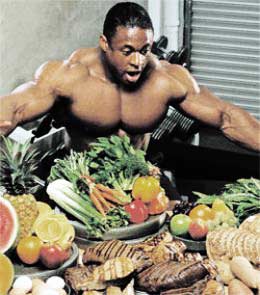
From participating and hanging out backstage at a multitude of bodybuilding events, I’ve learned they’re a vast number of different approaches to fat loss when it comes getting extremely lean.
Every bodybuilding fat loss diet has its positives and negatives, but they’re all relatively effective for shredding excess body-fat if followed correctly.
Here are five bodybuilding competition fat loss diets that I’ve personally tried with the pros and cons of each.
5 Bodybuilding Competition Diets: Pros and Cons
#1. Low Carb Diet
Any diet that restricts one’s carbohydrate intake below 20% of one’s daily caloric intake is considered a low carb diet.
Pros:
Low carb diets are extremely effective at burning fat stores. They work by decreasing the body’s blood glucose, insulin, and glycogen stores which turns the body into a fat burring furnace. During my experience with a low carb diet, at times I felt as though fat was melting off of me. Also, the decreased carbohydrate intake leads to less water retention in the body making the dieter appear leaner within just days which I also enjoyed. Additionally, some individuals will feel satisfied after meals during a low carb diet despite the fact they may be eating less calories.
Cons:
Depleting the body’s glycogen stores may be a positive for fat loss, but it’s a big negative when it comes to retaining muscle mass. Muscle glycogen is comprised of stored carbohydrates which is the body’s preferred fuel source during strength training. Without this stored energy, your workouts will likely lack the intensity needed to preserve muscle mass. Personally, I felt as though I was dragging during my workouts while on a low carb diet. However, your body will eventually compensate by converting fatty acids into energy, this happens at a much slower rate and chances are you’ll still feel depleted and drained throughout your workout.
#2. Calorie Reduction
A calorie restricted or calorie reduced diet is any diet that restricts one’s calorie intake to below their body’s maintenance calories. Although all successful fat loss diets require a reduction of calories, this protocol focuses on calories only and not the macronutrients consumed.
Pros:
This is a very simple diet to follow. It’s nothing more than reducing the amount of calories you consume on a daily basis. For me, it was as simple as reducing my portion sizes at every meal. At first, your body will begin to shed body-fat as an attempt to balance out its energy expenditure, and it will continue to do so as long as you incorporate re-feeds into the diet. Also, this diet allows you to continue eating carbohydrates so you’ll have an easier time retaining muscle during a calorie deficient state.
Cons:
If one doesn’t include re-feeds into their calorie restricted diet, the body will eventually adjust to the diet by slowing down its energy expenditure. People refer to this as the body’s metabolism slowing down or a metabolic crash and it’s a culprit of fat loss plateaus. I learned this the hard way during one of my contests preps when my weight loss came to a halting stop regardless of the fact I continued to lower my calories. Another drawback to a calorie restricted diet is that some individuals will still feel hungry and unsatisfied after meals which could result in food binges.
#3. If It Fits Your Macros
This style of dieting is based upon meeting the caloric and individual macronutrient needs relevant to an individual’s goals. Basically, you can eat foods of personal preference as long as at the end of the day you’ve stayed within your caloric and macronutrient guidelines.
Pros:
The fact that you aren’t restricted in your food choices is what makes this diet enjoyable and easy to adhere to. Also, this diet is very effective at shedding body fat if you set your caloric intake and macronutrient guidelines properly. Following this protocol allowed me to still enjoy social functions during my diet without the need of bringing my food in tupperware containers.
Cons:
This diet hinges on the ability of the dieter to set correct macronutrient and caloric guidelines. This isn’t ideal if the dieter isn’t experienced in formulating weight loss diets. Also, the fact you’re given the freedom to select foods of personal preference could end up working against you. For instance, if you consume a high carbohydrate meal in the morning, this could leave you restricting carbs the rest of day which isn’t a walk in the park.
#4. Intermittent Fasting
There a few methods of intermittent fasting. Some fasting methods are daily while others are full day fasts. One of the most popular in the bodybuilding community is the leangains protocol which is a daily 16 hour fast followed by an 8 hour feeding period.
Pros:
Surprising, one of the pros of this diet is it’s pretty easy to follow. Usually, you’ll start your fast in the evening say around 8pm, and then you’ll simply skip breakfast and start your feeding period around noon. Meals are generally bigger because you only have an 8 hour window to eat which leaves you pretty satisfied after meals. Contrary to what I believed before trying this diet, my metabolism didn’t slow at all and I had no problem losing fat on this diet.
Cons:
Some of the cons of this diet were hunger (duh) towards the latter part of the fast, extreme lethargy post meals, overeating during the feeding period as you tend to reach for dense high calorie meals, and feeling bloated during the feeding part of the diet. The bloating feeling is more than likely because you’re trying to consume a full day’s worth of calories in 8 hours.
#5. Low Fat
A low fat diet is a diet that limits one’s fat intake below 20% of an individual’s daily calories. Low fat diets were extremely popular in the 1990’s as fat was seen as the culprit of many health related issues. However, today we recognize that some fats are indeed healthy for us.
Pros:
With a low fat diet, you can consume a large amount of carbohydrate and protein rich foods because they contain half the amount of calories per gram as fats do. Carbohydrates and proteins contain 4 calories per gram while fat contains 9 calories per gram. What this means is you’re able to consume a large quantity or volume of food without taking in an excess of calories. As a bodybuilder, it’s an all-out fruit, vegetable, chicken, and tilapia galore.
Cons:
Unfortunately for low fat dieters fat plays a crucial role in satiation, hormone production, and vitamin absorption. My experience with low fat dieting no doubtably left me experiencing hunger after meals even though I consumed a large amount of food with an adequate amount of calories. Also, I believe I did experience a drop in testosterone as I experienced several symptoms of low testosterone, but I don’t have any scientific proof such as blood work to confirm my suspicion.
Final Thoughts
Depending on the individual, one diet approach may be more favorable and appealing than the others. However, the best fat loss diet in the world won’t do you any good if you cannot follow the guidelines. Therefore, the most beneficial fat loss diet is the one you can adhere to the best.
I suggest trying out different fat loss diets for an extending amount of time (3 months). This will allow you to find out what diets work best for your physique, and what diets you’re able to consistently follow.
Finding the right diet for you may be a great deal of trial and error, but having a lean physique makes the journey well worth it.
Meat-Free Muscle Building: Nutrition Tips for Vegans
By Julian Brown, BS, ACE-CPT, NASM-FNS
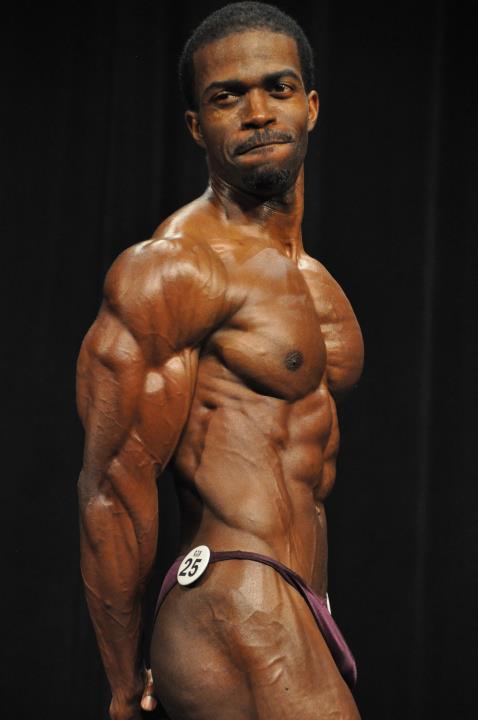
It has been well documented that protein helps with the formulation and repair of muscle tissues. Therefore, individuals looking to build muscle mass should consume an adequate amount of protein in their diet along with a proper exercise program.
The amount of protein needed for optimal results varies from individual to individual, but typically when people think of protein sources needed for building lean strong muscles, the foods that come to mind are lean meats, eggs, dairy, and whey protein.
However, due to religious, personal, health, or political reasons, there are many groups of people whom do not consume meat or any food derived from an animal. Generally, these people are referred to as vegans or vegetarians.
Is it possible to build muscle without consuming proteins derived from animals?
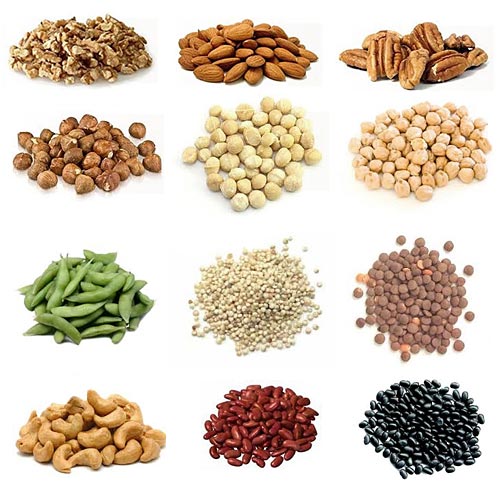 The answer is absolutely. Believe it or not, there have been plenty of people who have successfully built great physiques without eating animal products.
The answer is absolutely. Believe it or not, there have been plenty of people who have successfully built great physiques without eating animal products.
A big misconception is that one cannot get an adequate amount of protein or enough complete proteins by simply eating grains, fruits, vegetables, and legumes alone.
However, it is possible to get more than enough protein intake from meat free sources.
Examples include but are not limited to:
Seeds
A half cup of hemp seeds provides roughly 26 grams of protein; a half cup of pumpkin seeds has about 18 grams of protein; a half cup of sesame seeds provides around 10 grams of protein; and a half cup of sunflower seeds has round 13 grams of protein.
Quinoa
A cup of quinoa (uncooked) provides about 20 grams of protein.
Edamame
A cup of this vegetable contains a whopping 16 grams of protein.
Chickpeas
Canned Chickpeas contain around 12 grams of protein per cup.
Lentils
This legume provides approximately 18 grams of protein per cup.
Raw Nuts
A half cup of whole almonds provides 15 grams of protein; a half cup of peanuts has about 14 grams of protein; a half cup of cashews contains roughly 10 grams of protein; and a half cup of pistachio provides about 12 grams.
Beans
A cup of canned black beans provides 15 grams of protein; a cup of canned pinto beans contains 13 grams of protein; and a cup of canned kidney beans 13 grams of protein.
Vegan Protein Powders
There are a variety of different brands of vegan protein powders and the majority of them provide roughly around 20 grams of protein per serving.
What about complete proteins?
Complete proteins are a source of protein that contains an adequate proportion of all nine of the essential amino acids. All animal products contain complete proteins, but there are only five plant sources that are complete proteins. They include quinoa, buckwheat, hempseed, blue green algae, and soybeans. Although most grains, legumes, and nuts are not complete proteins, it is possible to consume all the essential amino acids by pairing two of the aforementioned three food groups. For example, beans and rice, oats and almonds, or kidney bean walnut salad.
Lay the misconceptions to rest. With proper nutrition and supplementation, it is more than possible to consume the necessary proteins to build a significant amount of muscle mass without animal products.
Complimentary Bodybuilding Supplements
By Julian Brown, BS, ACE-CPT, NASM-FNS
As a professional natural bodybuilder, I know first-hand there’s no substitute for a good diet and exercise training program. However, properly supplementing your diet and exercise program can without a doubt help you improve your results. In no particular order, here are my favorite bodybuilding supplements.
Protein
Lifting weights stresses and breaks down muscle tissue and in response to this stress, the body adapts by using protein to make the muscles bigger and stronger. Protein, which is comprised of amino-acids, helps the body repair, and rebuild stressed/damaged tissues in the body. Ideally, as a bodybuilder you should try to consume at least .8 grams of protein per lb bodyweight on a daily basis. That’s roughly 144 grams of protein for a 180lb person. However, reaching those requirements isn’t necessarily easy and can involve loads of cooking. By supplementing with protein, you can reach those requirements and save yourself some time in the kitchen if you’re in a hurry.
Creatine
During times of intense energy expenditure like weight training, adenosine triphosphate (ATP) is rapidly depleted (seconds) from the muscle cells and can take minutes to replenish. However, supplementing with creatine supplies the muscles with more energy by helping with the formulation of (ATP). Therefore, allowing you to do more work for a longer period of time which in turn should lead to more muscle gains, but when it comes to creatine, more isn’t necessarily better. Because your muscles and body can only store so much, supplementing with approximately 5-10 grams daily pre or post workout is ideal.
EFA’s
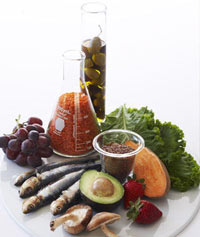 Essential Fatty Acids aka healthy fats help suppress the production of pro-inflammatory compounds in the body, provide us with energy, help us absorb vitamins, and supports a strong immune system. Plus, according to research published in the Journal of Applied Physiology by a team of Penn State University researchers, a positive correlation exists between dietary fat and testosterone levels. EFA’s also play key roles in benefiting conditions such as arthritis, diabetes, inflammatory bowel disease(IBS), autoimmune disorders, and aging. Because EFA’s cannot be made in the body, they must be obtained through diet and/or supplementation. Exactly how much do you need? The USDA recommends that only 20%-35% of your diet come from dietary fat as these ranges have been associated with a reduced risk of chronic diseases, and it provides adequate fat intake for essential nutrient absorption.
Essential Fatty Acids aka healthy fats help suppress the production of pro-inflammatory compounds in the body, provide us with energy, help us absorb vitamins, and supports a strong immune system. Plus, according to research published in the Journal of Applied Physiology by a team of Penn State University researchers, a positive correlation exists between dietary fat and testosterone levels. EFA’s also play key roles in benefiting conditions such as arthritis, diabetes, inflammatory bowel disease(IBS), autoimmune disorders, and aging. Because EFA’s cannot be made in the body, they must be obtained through diet and/or supplementation. Exactly how much do you need? The USDA recommends that only 20%-35% of your diet come from dietary fat as these ranges have been associated with a reduced risk of chronic diseases, and it provides adequate fat intake for essential nutrient absorption.
Caffeine
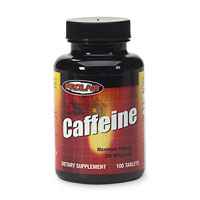 Caffeine competes with adenosine, which is responsible for slowing down nerve activity in the body, and therefore effectively blocks adenosine receptors in the central nervous system (CNS) causing a stimulatory effect on the body. This surge in energy can provide you with what you may need to maximize your workout by allowing you to work harder and longer. According to a study published in the Journal of Strength and Conditioning Research in 2006, subjects increased their one-rep max for the bench press simply by having a caffeinated drink one hour before training. However, it is very important for bodybuilders to understand their caffeine limit as too much caffeine has been associated with negative effects such as sleep deprivation, nausea, cramping, anxiety, fatigue, headaches, gastrointestinal instability, muscle tightness, muscle cramping, and dehydration.
Caffeine competes with adenosine, which is responsible for slowing down nerve activity in the body, and therefore effectively blocks adenosine receptors in the central nervous system (CNS) causing a stimulatory effect on the body. This surge in energy can provide you with what you may need to maximize your workout by allowing you to work harder and longer. According to a study published in the Journal of Strength and Conditioning Research in 2006, subjects increased their one-rep max for the bench press simply by having a caffeinated drink one hour before training. However, it is very important for bodybuilders to understand their caffeine limit as too much caffeine has been associated with negative effects such as sleep deprivation, nausea, cramping, anxiety, fatigue, headaches, gastrointestinal instability, muscle tightness, muscle cramping, and dehydration.
Multi-Vitamins
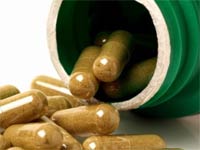 Vitamins are an essential micro-nutrient that you need in order to be healthy and perform at your best athletically. Generally, since we cannot synthesize vitamins or can only do so in amounts insufficient enough to meet our body needs, they must be obtained from the diet. Ideally, you want to be consuming these vitamins through foods, but dietary supplements can help if you aren’t getting adequate amounts from your diet. As a bodybuilder, it’s reasonable to think that you may need extra vitamins and minerals compared to the average person for two reasons. First, you’re burning hundreds of extra calories through intense physical activity, and second, many bodybuilders are in caloric deficient state as they’re attempting to lose fat. A mineral deficiency may impair performance so it’s important to supplement with a multi-vitamin to ensure you aren’t deficient in any vitamins and minerals.
Vitamins are an essential micro-nutrient that you need in order to be healthy and perform at your best athletically. Generally, since we cannot synthesize vitamins or can only do so in amounts insufficient enough to meet our body needs, they must be obtained from the diet. Ideally, you want to be consuming these vitamins through foods, but dietary supplements can help if you aren’t getting adequate amounts from your diet. As a bodybuilder, it’s reasonable to think that you may need extra vitamins and minerals compared to the average person for two reasons. First, you’re burning hundreds of extra calories through intense physical activity, and second, many bodybuilders are in caloric deficient state as they’re attempting to lose fat. A mineral deficiency may impair performance so it’s important to supplement with a multi-vitamin to ensure you aren’t deficient in any vitamins and minerals.
Supplements are by no means a replacement for a solid diet and exercise program. However, properly complimenting your diet with certain dietary supplements can help you improve your results.
The Effects of Alcohol on Bodybuilding
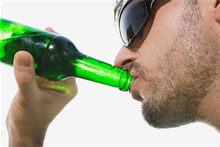
By Julian Brown, BS, ACE-CPT, NASM-FNS
As a competitive bodybuilder, I know how important one’s physique can be. However, as important as it is I’ll still enjoy a drink at a social function every now and then. Although having a drink every once in a while won’t destroy your physique, consistent alcohol consumption can hinder your muscle gains and wreak havoc on your physique by decreasing fat oxidation, decreasing protein synthesis, and lowering testosterone levels. For those reasons, if you want to truly maximize your muscle gains and fat loss, you’ll keep your alcohol consumption at a minimum.
Fat Oxidation
 Fat oxidation is a catabolic process in which fatty acids are broken down by the body to be used as energy. According to a study published in the American Journal of Physiology, exercise increases fat oxidation at rest without changes to one’s dietary intake 3. Meaning, exercise causes you to burn more fat calories when you’re sleeping, at work, watching television, etc. without having to even change your diet, but this is not the case if you’re having a drink during your down time. A study in the New England Journal of Medicine concluded that alcohol decreases fat oxidation and habitual consumption of alcohol favors fat storage and weight gain2. When just 24 grams of alcohol is consumed, which is less than 2 beers, the liver produces enough acetate to decrease the body’s fat oxidation by a massive 73% according to the American Journal of Clinical Research1. Therefore, it is extremely important as a bodybuilder to limit your alcohol consumption to ensure you don’t inhibit your fat burning capabilities. Additionally, it is important to remember that alcohol supplies the body with extra calories that aren’t required for optimum function. By consuming alcohol not only does it impair the body’s ability to burn fat as an energy source, but it also hinders the body’s ability to repair muscle tissue.
Fat oxidation is a catabolic process in which fatty acids are broken down by the body to be used as energy. According to a study published in the American Journal of Physiology, exercise increases fat oxidation at rest without changes to one’s dietary intake 3. Meaning, exercise causes you to burn more fat calories when you’re sleeping, at work, watching television, etc. without having to even change your diet, but this is not the case if you’re having a drink during your down time. A study in the New England Journal of Medicine concluded that alcohol decreases fat oxidation and habitual consumption of alcohol favors fat storage and weight gain2. When just 24 grams of alcohol is consumed, which is less than 2 beers, the liver produces enough acetate to decrease the body’s fat oxidation by a massive 73% according to the American Journal of Clinical Research1. Therefore, it is extremely important as a bodybuilder to limit your alcohol consumption to ensure you don’t inhibit your fat burning capabilities. Additionally, it is important to remember that alcohol supplies the body with extra calories that aren’t required for optimum function. By consuming alcohol not only does it impair the body’s ability to burn fat as an energy source, but it also hinders the body’s ability to repair muscle tissue.
Protein Synthesis
 Protein synthesis is the process of which individual cells construct proteins. Because skeletal muscle fibers are composed of a number of different proteins, protein synthesis is a vital component to muscular growth. Weight training causes stress and trauma to the muscle fibers which stimulates the body to increase protein synthesis in order to rebuild/repair the damaged muscle tissue making it larger and stronger this is known as muscular hypertrophy. However, as little as one beer decreases protein synthesis by as much as 20% for up to a 24 hour period4. This hinders your body’s ability to adequately repair itself thus limiting your muscular growth. Consistently consuming alcohol overtime would not only limit your body’s ability to grow larger muscles via protein synthesis, but it also limits muscular growth by decreasing the body’s testosterone levels.
Protein synthesis is the process of which individual cells construct proteins. Because skeletal muscle fibers are composed of a number of different proteins, protein synthesis is a vital component to muscular growth. Weight training causes stress and trauma to the muscle fibers which stimulates the body to increase protein synthesis in order to rebuild/repair the damaged muscle tissue making it larger and stronger this is known as muscular hypertrophy. However, as little as one beer decreases protein synthesis by as much as 20% for up to a 24 hour period4. This hinders your body’s ability to adequately repair itself thus limiting your muscular growth. Consistently consuming alcohol overtime would not only limit your body’s ability to grow larger muscles via protein synthesis, but it also limits muscular growth by decreasing the body’s testosterone levels.
Testosterone
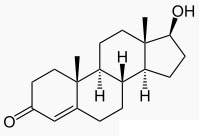 When it comes to building muscle tissue testosterone is the king of hormones. Studies show that testosterone, especially when combined with strength training, increases fat-free mass and muscle size and strength6. In other words, the more testosterone the body has the better the body’s muscle building capabilities. However, alcohol consumption lowers your testosterone levels; therefore, limiting the body’s capability to increase/build muscle mass. Studies show that moderate alcohol consumption (3-4 drinks per day) reduced plasma testosterone levels in men by as much as 6.8% in a 3 week period5. If you want to keep your testosterone levels high, I’d recommend not consuming alcohol on a daily basis.
When it comes to building muscle tissue testosterone is the king of hormones. Studies show that testosterone, especially when combined with strength training, increases fat-free mass and muscle size and strength6. In other words, the more testosterone the body has the better the body’s muscle building capabilities. However, alcohol consumption lowers your testosterone levels; therefore, limiting the body’s capability to increase/build muscle mass. Studies show that moderate alcohol consumption (3-4 drinks per day) reduced plasma testosterone levels in men by as much as 6.8% in a 3 week period5. If you want to keep your testosterone levels high, I’d recommend not consuming alcohol on a daily basis.
Final Thoughts
This article wasn’t meant to deter you from drinking completely, but meant to educate you on how alcohol can affect your physique. A drink every now and then won’t destroy your physique, but habitual alcohol consumption can definitely spoil some of your hard efforts in the gym by decreasing the body’s ability to burn fat and repair muscle. When it comes to building a superior physique maximizing your efforts in the gym is critical. If getting the most out of your gym efforts is vital to your personal goals, then you’ll keep your alcohol consumption at a minimum.
The Effects of Alcohol on Bodybuilding: References
1^Siler, S.Q., Neese, R.A., & Hellerstein, M.K. (1999). De novo lipogenesis, lipid kinetics, and whole-body lipid balances in humans after acute alcohol consumption. American Journal of Clinical Nutrition, 70, 928-936
2^Paolo M. Suter, M.D., M.S., Yves Schutz, Ph.D., M.P.H., and Eric Jequier, M.D. The Effect of Ethanol on Fat Storage in Healthy Subjects N Engl J Med 1992; 326:983-987
3^Calles-Escandon J, Goran MI, O’Connell M, Nair KS, Danforth E Jr. Exercise increases fat oxidation at rest unrelated to changes in energy balance or lipolysis. Am J Physiol Endocrinol Metab 270: E1009–E1014,1996.
4^Hong-Brown, L. Q., Frost, R. A. and Lang, C. H. (2001), Alcohol Impairs Protein Synthesis and Degradation in Cultured Skeletal Muscle Cells. Alcoholism: Clinical and Experimental Research, 25: 1373–1382. doi: 10.1111/j.1530-0277.2001.tb02361.x
5^Sierksma, A., Sarkola, T., Eriksson, C. J. P., van der Gaag, M. S., Grobbee, D. E. and Hendriks, H. F. J. (2004), Effect of Moderate Alcohol Consumption on Plasma Dehydroepiandrosterone Sulfate, Testosterone, and Estradiol Levels in Middle-Aged Men and Postmenopausal Women: A Diet-Controlled Intervention Study. Alcoholism: Clinical and Experimental Research, 28: 780–785. doi: 10.1097/01.ALC.0000125356.70824.81
6^Bhasin S, Storer TW, Berman N, Callegari C, Clevenger B, Phillips J, Bunnell TJ, Tricker R, Shirazi A, Casaburi R (July 1996). “The effects of supraphysiologic doses of testosterone on muscle size and strength in normal men”. N. Engl. J. Med. 335 (1): 1–7.
Why Bodybuilding And Alcoholism Don’t Mix
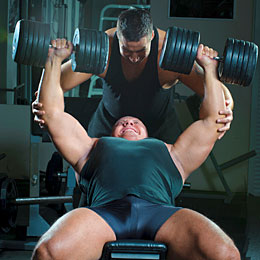 In the modern society, it has become a social norm to indulge in alcohol at social gatherings. Both formal and informal events usually offer alcohol to the guests making it part of our culture. As a result, most people prefer indulging in alcohol over the weekend. After a week of working hard, interacting with a few people over drinks is an excellent way to unwind for numerous people before resuming back to work on Mondays.
In the modern society, it has become a social norm to indulge in alcohol at social gatherings. Both formal and informal events usually offer alcohol to the guests making it part of our culture. As a result, most people prefer indulging in alcohol over the weekend. After a week of working hard, interacting with a few people over drinks is an excellent way to unwind for numerous people before resuming back to work on Mondays.
For bodybuilders, their week of hard work includes adhering to strict diets, training schedules and focused plans of achieving their goals like drinking lots of water. Just like other members of society, they also might indulge in social alcoholic drinking over the weekends. While some may believe that as long as they stay healthy and work out, alcohol will not affect them, it interferes with their metabolism and muscle gain. For those who still think alcohol does not affect them, there is a relationship between alcoholism and muscle strength. This article provides the necessary information on how alcohol saps muscle strength.
Top 4 Reasons Why Alcohol and Bodybuilding Don’t Mix
Here are some of the reasons why bodybuilding and alcoholism do not mix:
#1. Dehydration
When it is used in excess, alcohol reduces the amount of hormone that the body uses to reabsorb water.Furthermore, the increased urination and the occasional vomiting further drain the body of fluids. When your body is dehydrated, there might not be harmony between the nutritional, hormonal and metabolic activities that affect muscle growth. Also, dehydration caused by alcohol affects the performance levels by altering the body’s energy creation mechanism.
#2. It Affects Protein Synthesis
Protein synthesis is the process in which food material turns into muscle. The consumption of alcohol slows down this process. Thus, it inhibits muscle growth and prevents bodybuilders from optimum development.
#3. It Affects the Testosterone
Testosterone is a hormone that plays a crucial role in promoting protein synthesis in the body. It fosters the increment of muscle mass, bone density, and toughness. Not only does alcohol lower testosterone levels in human beings, but also, it raises the estrogen levels and creates a hormonal imbalance in the body. As a result, the muscle is not able to carry out protein synthesis, and the muscles may not grow.
#4. May Increase Body Fat
Alcohol contains a lot of calories with no nutritional value. On average, alcohol has seven calories per gram. Excessive consumption of alcohol means consumption of more calories, which hinders body metabolism by reducing the amount of fat the body burns for energy. When the body is trying to get rid of the fat in alcohol, it interrupts other processes like absorption of nutrients.
The Bottom Line
Although, it is a societal norm to drink and let loose from time to time, the consumption of alcohol may undo all the previous hard work. As explained in this article, alcohol affects the performance of the body and the general muscle growth. However, this is not discouraging bodybuilders from indulging in alcohol. For training days, little or no consumption of alcohol is highly encouraged to allow the body to recover and achieve optimum performance and full growth.
Weight Training Tips For Bodybuilders
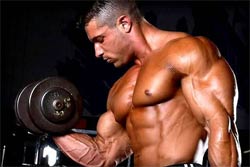 By Julian Brown, BS, ACE-CPT, NASM-FNS
By Julian Brown, BS, ACE-CPT, NASM-FNS
There isn’t a one size fits all bodybuilding weight training routine, but there are a few principles you should be following if you want to maximize your results.
Muscular hypertrophy, an increase in muscle size due to the stress induced from strength training, is affected by a vast amount of factors such as workout frequency, intensity, and volume1.
In this article, I’ll teach you how to maximize muscle growth by incorporating periodization, progressive overload, and exercise variety into your weight training routine.
Periodization
Periodization is the concept of altering exercise variables such as volume, intensity, and frequency over time to optimize training progress. It allows us to train at a high intensity or volume with alternating periods of lower intensity or volume to facilitate recovery and to maximize performance.
In addition to, an article published in Journal of Strength and Conditioning Research concluded periodized programs can result in greater strength (1 Rep Max) gains than non-periodized multi-set and single-set programs2.
There are a number of different periodization models, the most popular probably being the original model of linear periodization. With linear periodization, every 4-6 weeks (phase) the reps/volume decrease while weight/intensity increases. e.g. phase one 15 reps with 100lbs, phase two 12 reps with 110lbs, phase three 10 reps with 120lbs, phase four 8 reps with 130lbs. However, this isn’t the most effective form of periodization.
Non-linear periodization focuses on changing the exercise variables on a more frequent basis e.g. Monday 15 reps with 100lbs, Wednesday 10 reps with 130lbs, Friday 5 reps with 160lbs. A study published by Journal of Strength and Conditioning Research concluded that for maximizing strength increases, daily intensity and volume variations were more effective than weekly variations3. Try changing up your weight/intensity and reps/volume each workout for maximum strength gains.
Progressive Overload
If you use the same amount of resistance for the same number of reps every workout, there will be no improvement beyond the point of which you’ve already reached1. Progressive overload is the concept of gradually increasing the demands of the body during exercise in order to increase strength and muscle mass1. Thus, meaning you need to continually lift more challenging weights to build more muscle mass.
Conversely, if the demands on your muscles are not at least maintained and are actually decreased, your muscles will become smaller and weaker1. This is why it is critical to include to progressive overload into your training program if you want to continue making progress. Try increasing resistance, reps, sets, training frequency, or the amount of exercises you do every 6-8 weeks to ensure muscular overload in your training program.
Exercise Variety
Bored of your workout, dreading squats today, not making any progress? Breaking plateaus and staying mentally focused are two benefits you’ll receive by adding a variety of exercises to your workout. Your muscles become very efficient at the exercises they are accustomed to doing and if performed with same intensity over a long period of time, eventually this adaption will lead to a plateau4.
However, by switching up the exercises or the order of exercises, the workout becomes more challenging which can stimulate muscle growth helping you break through a plateau. Exercise variety also helps you stay mentally focused by providing you with enjoyable new exercises and a psychological break from exercises you dread. Try doing your workout routine out of order, in reverse, using dumbbells instead of barbells, cables instead of machines, decline instead of incline, and vice versa to optimize training variety in your routine.
Start maximizing your results today by incorporating periodization, progressive overload, and exercise variety into your weight training routine.
Bodybuilding Weight Training Tips 101: References
- 1^ “ Fitness: The Complete Guide;” International Sports Sciences Association; 2007
- 2^ Journal of Strength and Conditioning Research ,2009 Dec;23(9):2437-42
- 3^Journal of Strength and Conditioning Research, 1999, 13(1), 82–89
- 4^Kraemer, William J.; Zatsiorsky, Vladimir M. (2006). Science and practice of strength training. Champaign, IL: Human Kinetics. p. 15.
Top Tips for Choosing a Bodybuilding Split Program
Introduction
First of all, there’s no such thing as the best bodybuilding split program. It depends upon your goals. To ask which is the best for you would be like calling a men’s store to order a suit, without telling them what style or size you want, what color you prefer or whether it’s for business or a funeral. There’s no one-size-fits-all solution. The bodybuilding split program that’s best for you will be periodized and designed to fit your specific goals.
As a rule of thumb, if your goal is increased muscle size (hypertrophy), you’ll need to make metabolic adaptations to your program – higher weights at lower reps. But if strength is your goal, then neuromuscular adaptations will be the ticket – more reps at a constant weight.
Designing a Bodybuilding Split Program to Achieve Your Goals
There are a lot of different split programs out there, many of which are effective. But the truth is, none of them are ideal. The best bet is to build your own program, based upon two major factors:
- Your goal – bulk, strength or endurance?
- Your training age – how long have you been bodybuilding? If you have six months or less at it, I’d recommend you stay with a whole-body plan for six months before you even consider moving to a split program. As a relative newcomer, you shouldn’t need to make any changes to your routine for several weeks. If you’ve been at it for more than six months, though, you’ll probably need to change your routine more often, so you don’t plateau. At that level, you may be a good candidate for split training.
Of course, you’ll have to take other factors into account when you build your split program, but those two will be your plan’s foundation.
Optimum muscle growth demands an optimum environment
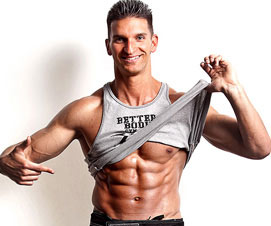
Considering your personal goal and the training you already have under your belt still leaves you needing to look at other program needs that are specific to you. Sorting through the pros and cons of different split programs can help you select the one that will most effectively get you where you want to be. Here are some of the things you should consider:
- Don’t just focus on your main muscles. Assisting muscles play an important part in strength and endurance, as well as definition. Your program should be designed to address them, too, in a sequence that constantly complements the preceding workout.
- Give your upper body a break, by using a day dedicated to your legs to give some rest to your arms and trunk.
- Remember that two days of intense workouts can deplete your glycogen levels, so it’s a good practice to intersperse rest days between workouts of shared muscles. This will also give those shared muscles an opportunity to recharge, making their next workout more effective.
- While it may seem to be a strange idea, consider designing your split program to do your chest and arms together, particularly when they’re fresh after a day off. I know it may sound crazy but since they’re both large muscle groups that work in unison, you can see some great benefits from the resulting explosive workouts.
- Never forget that your muscles need the rest days to rebuild and grow. They’re just as critical as your workout days because without rest, your workouts won’t be as effective.
- Design your program with flexibility for change, to avoid plateaus. As you progress in your training, you’ll find that you’ll need to make changes more often. This is a critical aspect of any split training program.
Fine-tune Your Bodybuilding Split Program to Optimize the Pros and Cons
When you’re designing your program, you’ll need to analyze it to spot the weak spots and make adjustments to minimize their impact. For instance, if you work your shoulders and chest together with the support of your triceps, then your triceps will already be fatigued before you get around to focusing on them. If you reverse your split on the next change-up, you’ll minimize that impact by hitting your triceps while they’re still fresh.
So when you change, go after your triceps first, then follow with your shoulders, then the chest. All three will get equal treatment that way. The next time you change, rotate their sequence again.
Lost time can’t be reclaimed, so make every minute count. Ensuring that your program is designed to be as effective as possible will make every minute of gym time productive and you’ll achieve your goal that much faster. Failing to optimize the pros and cons in your split program will work against you, so work smarter, rather than harder.
Bodybuilding Exercises You Don’t See Everyday
By Julian Brown, BS, ACE-CPT, NASM-FNS
Typically, when you’re in the gym you see different gym goers performing the same standard exercises.
Although these exercises may be proven effective, you might be looking to add some variety to your routine.
So without further ado, here are some exercises you generally won’t see at the gym every day.
Exercise: Lying Side Dumbbell Flyes
Muscle Worked: Chest
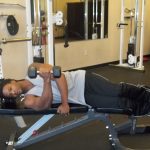
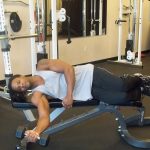
How to do it: Lying sideways on a bench, start by holding a dumbbell with your bottom arm just below your shoulder, keep your elbow slightly bent in a locked position and raise the dumbbell until its parallel with your top arm’s shoulder then slowly descend back into your starting position
Exercise: Lat Shrugs
Muscles Worked: Back
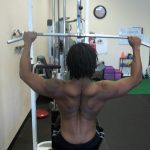
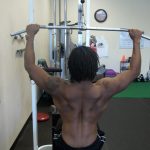
How to do it: Using a lat pull-down machine, start by gripping the bar with a wide grip while keeping your elbows slightly bent in a locked position. Contract your shoulder blades downward and pause in this position before returning to your starting position.
Exercise: Barbell Hack Squats
Muscles Worked: Legs
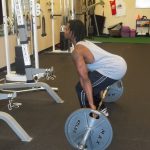
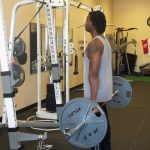
How to do it: Start by standing straight while gripping a barbell with a shoulder width grip behind you. While keeping your back straight and head up, squat until your thighs are parallel with the floor then return to the standing position by pushing up through the heel s of your feet.
Exercise: Scott Press
Muscles worked: Shoulders
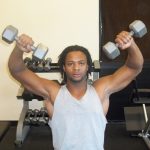

How to do it: Start with elbows bent at a 90 degree angle with arms in front and dumbbells about face height. From there, moving only your shoulders, imagine doing a lateral raise and lift your shoulders until your elbows are just above shoulder height.
Exercises: Body Weight Tricep Extensions
Muscles Worked: Triceps
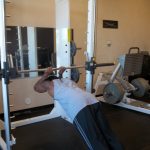
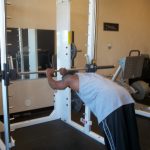
How to do it: Start by standing about a foot in front of a smith machine with the bar about waist height, grip the bar with a narrow grip (hands about 6-10 inches apart), keep your elbows tucked then lower your body forward until your head goes underneath the bar. Keeping your body rigid and tight, use your triceps to extend back into the starting position.
Exercise: Hercules Curls
Muscles Worked: Biceps
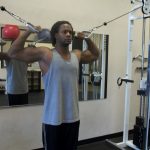
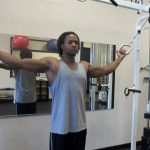
How to do it: Using a cable crossover, start by standing in the middle of the cable cross machine while gripping both handles. Keeping your arms shoulder height, curl both arms towards shoulders by flexing your biceps. Pause in this position for a moment before returning to the starting position.
Exercise: Barbell Calf Rock Ups
Muscles Worked: Calves
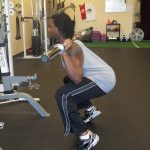
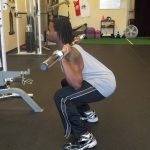
How to do it: Starting in the squat position with a barbell on your back, raise your heels as high as you can by contracting your calf muscles. Pause in this position for a moment before returning to the starting position.
Exercise: Stomach Vacuums
Muscles Worked: Transverse Abdominals
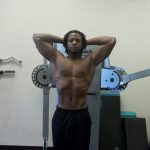
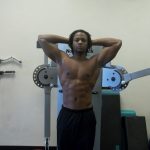
How to do it: Start by standing upright and placing your hands on your hips or on your head, and exhale all the air out of your lungs and bring your stomach in as much as possible, and hold. Hold this position for as long as you can, then return to the starting position.
Injuring yourself doing a new exercise will hinder your progress so before jumping into exercises you’ve never performed; here are few things to keep in mind. First, start with a light weight and work your way up. Second, maintain proper form throughout the entire movement and lastly, check your form in the mirror if possible.
Back Muscle Building Tips for Bodybuilders
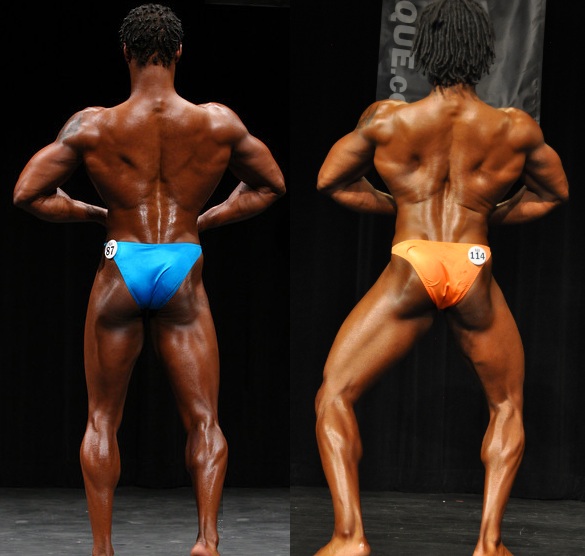
Julian’s Back Transformation
By Julian Brown, BS, ACE-CPT, NASM-FNS
After my first bodybuilding competition, I realized that my back muscles weren’t as developed as I had thought. However, this wasn’t due to a lackluster effort in the gym during my back workouts.
Because my back muscles are one of my favorite muscle groups to train, my intensity and effort on these days were always at a high level. So what gives? I needed to take a step back and take a closer look at my workout routine.
What I found is that I needed to start training smarter instead of harder, and if you’re looking to build a better back, I’ve got some helpful advice based on personal experience for you.
My Approach
In my early bodybuilding years, I used a typical one body part per day bodybuilding training split. After all, that’s what the muscle magazines touted as the most effective bodybuilding training protocol. However, when I looked at this routine from a body movement perspective, I quickly discovered I was doing twice as many pressing movements than pulling movements.
Here’s what I mean. Each week I dedicated one day to pressing vertically for my shoulders and one day to pressing horizontally for my chest. However, when it came to my back muscles, I did both horizontal and vertical pulling in the same day.
How I Changed Things
After my realization that I was pressing twice as much as I was pulling, I decided change how I performed my back workouts. Not only would I start training my back twice a week, but I would also split the focus of each of my back workouts. I decided to dedicate one back workout to horizontal pulls and one back workout to vertical pulls.
Just to clarify a horizontal pull is any pulling movement or exercise where your hands move at a horizontal angle in relation to your body such as t-bar rows, dumbbell rows, cable rows, etc., and a vertical pull is any pulling movement or exercise where your hands move at a vertical angle in relation to your body such as lat pull-downs, pull-ups, chin ups, close grip pull-downs, etc.
Once I started dedicating each back workout to a different movement, this is what happened.
The Results
The thickness and width of my back grew tremendously from the added frequency of my back workouts and the split focus of the type of back movements. Take it from me, if you’re looking to build a better back, split up your back workout into two separate workouts; vertical pulls and horizontal pulls.
If you’re looking for a more specific routine to build your back muscles, check out my comprehensive guide for developing muscular strength, stamina, and size. It’s called the MS3 Program and it’s available here: My Store.
Injury Prevention Tips for Bodybuilders
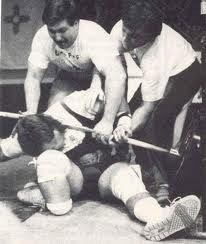 By Julian Brown, BS, ACE-CPT, NASM-FNS
By Julian Brown, BS, ACE-CPT, NASM-FNS
As a bodybuilder and avid exerciser, I know first-hand how injuries can affect your workout performance in the gym.
Injuries slow down your progress by forcing you to work around movements, lightening the load, and taking time off.
Successfully preventing injury from occurring in the first place is the best case scenario, but there are no guarantees when it comes to preventing injury. However, by following these tactics you can greatly reduce the risk of incurring a weight training related injury.
Adequate Warm-up
Too often bodybuilders jump from zero to their peak weight without adequately warming up their muscles and connective tissues. This type of training philosophy can leave bodybuilders prone to muscular or joint injuries.
Therefore, a proper warm-up should be a staple in your exercise routine. According to International Sports Sciences Association, warming up increases muscular strength, contractibility, extensibility, reduces the risk of injury, and prepares the connective tissue for work1.
To avoid wear and tear on your cold muscles, joints, and tendons try performing at least 2-3 lighter sets gradually progressing up to your max workload.
Proper Form
Using faculty biomechanics or bad form such as bouncing, jerking, or heaving while exercising with heavy resistance can potentially cause a damaging amount of stress to your connective tissues. However, using proper form can prevent you from causing any unnecessary stress or tension to your joints or tendons.
In weight training, proper form should ensure two things. First, the muscles you’re working receive full stress from the exercise performed, and second, your body is positioned in such a way that your muscles and joints are in the strongest position possible, thereby reducing the risk of training injuries.
To help maintain proper form during your workout, try exercising in front of the mirror for self correction, training with an experienced workout partner, or hiring a certified personal trainer.
Recovery
Recovery is generally one of the most over-looked parts to a strength training program. During the recovery stage, the body repairs, rebuilds, and strengthens itself. However, without sufficient time to repair and replenish, the body will continue to breakdown from intensive exercise increasing your risk for overuse injuries.
In addition to, excessive training has been shown to significantly decrease strength1. How much rest between weight training sessions do you need? Depending on several variables like volume and intensity, your muscles could take anywhere between 24 – 72 hours to recover.
Bodybuilders who train on consecutive days should do so performing a weight training split. A weight training split allows for recovery and aides in preventing overuse injuries by alternating the muscles exercised during a workout (Learn more about weight training splits here).
Consistently training hard enough to make progress from your workouts is hard enough already without injury. Warming up, using good form, and allowing yourself adequate recovery time can help you stay injury free while still pushing yourself to the max.
Bodybuilding Injury Prevention 101: References
1^ “ Fitness: The Complete Guide;” International Sports Sciences Association; 2007
Off-Season Motivational Tips for Bodybuilders
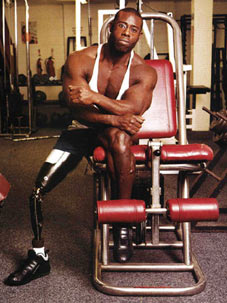
By Julian Brown, BS, ACE-CPT, NASM-FNS
Being a bodybuilder takes an enormous amount of dedication, but even the most dedicated could use a little motivational push every now and then.
Because bodybuilding is a lifestyle, it’s easy to lose focus and get sidetracked because of life’s everyday distractions. If you’ve been going through the motions in your workouts lately, here are a few motivational tips to push you back on track.
Bodybuilding Off-Season Motivation: 5 Tips for Success
#1: Goal Setting
What’s motivating you this off-season? Do you want bigger biceps or a leaner midsection? Establishing specific, measurable, and attainable goals are an extremely valuable tool for motivation and performance. According to a study published in the Journal of Sport & Exercise Psychology, setting moderate, absolute, and combined short and long term goals improves performance in sport1.
However, it’s not enough just to say you want a 31 inch waist. Write it down and outline a plan to get there so the next time you ask yourself why you’re doing all that strenuous work, you can read back your specific goals and get re-inspired. If you feel like your physique isn’t at its best because of a lagging body part, now is the time to improve your weak points. Try establishing specific goals and taking measurements and/or photos to access your progress.
#2: Fitness Competitions/Events
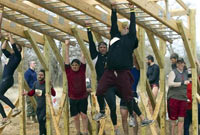 Generally, bodybuilders only compete in a few shows per year which can leave some competitors wanting more. Don’t just limit yourself to bodybuilding competitions, competing in other fitness related events and competitions can help scratch that competitive itch and keep you motivated throughout the rest of the year.
Generally, bodybuilders only compete in a few shows per year which can leave some competitors wanting more. Don’t just limit yourself to bodybuilding competitions, competing in other fitness related events and competitions can help scratch that competitive itch and keep you motivated throughout the rest of the year.
During the off-season, training and participating in power-lifting and cross-fit events and obstacle races like Tough Mudder and Warrior Dash can give you a psychological break from bodybuilding style workouts and add short term goals to your current workout routine.
#3: Training Partner
Training with a workout partner or a personal trainer is a great external source of motivation because they’ll provide you with accountability, encouragement, assistance on forced reps, and keep you focused on the task at hand. Also, on the days you may be dragging, you’ll be able to feed off your workout partner’s or personal trainer’s energy.
However, not all workout partners and personal trainers are created equal. Finding a quality workout partner or personal trainer is just as important as having one. Try to select a dependable workout partner with similar goals, or a personal trainer with a proven track record.
#4: Go New
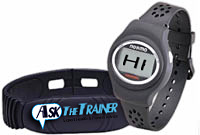 Going new is an excellent way to re-ignite your workouts. What do I mean by going new? I mean adding new workout gear, accessories, or gadgets to your current fitness routine.
Going new is an excellent way to re-ignite your workouts. What do I mean by going new? I mean adding new workout gear, accessories, or gadgets to your current fitness routine.
A new mp3 player, heart-rate monitor, outfit, straps, gloves, and a weight belt are just a few things that can give you a spark of motivation when you start to slip off the workout bandwagon. Try choosing a workout accessory or gadget that best suits your fitness needs and interests.
#5: Change of Environment
 Tired of the scenery at your gym? Switch locations. If your gym membership allows it, a change in scenery can be a great way to boost your motivation.
Tired of the scenery at your gym? Switch locations. If your gym membership allows it, a change in scenery can be a great way to boost your motivation.
Different gyms may have unique pieces of equipment that can provide new exercises into your routine, maybe less crowed at your normal workout time, or more free weight and cardio equipment, but you’ll never know unless you check it out.
Try switching gym locations, going to a local park with exercise equipment, or getting a guest pass at a different gym.
Stop going through the motions in your off-season, stay focused, get motivated, and get back to being dedicated.
Bodybuilding Off-season Motivation: References
- Journal of Sport & Exercise Psychology, Vol 17(2), Jun 1995, 117-137.
How to Add Lean Muscle Mass Without Adding Fat
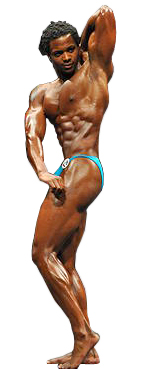
By Julian Brown, BS, ACE-CPT, NASM-FNS
Trying to add muscular size while limiting your fat gains is a difficult feat to accomplish, and there isn’t a one size fits all plan for achieving that objective. Although there are various body types such as ectomorphs, mesomorphs, endomorphs, and combinations of the three, having the right combination of nutrition, cardio, and weight training can lead to increases in muscularity with minimal to no fat gain regardless of your body type.
Eat More But Don’t Overdo it.
Gaining size requires an increase in caloric intake, but eating excessively will lead to the wrong type of size. Therefore, when it comes to increasing calories slow and steady wins the race. Aim for a conservative amount of weight gain such as 1lb-2lbs per month. This may sound like an extremely low monthly target, but let us look at it from a long-term perspective. If an individual gains 1lb- 2lbs per month for a year, that individual has gained somewhere between 12lbs-24lbs over the past 12 months. Realistically, gaining 12lbs of pure muscle in a year is an incredible accomplishment for a seasoned lifter. New lifters tend to grow at a faster rate for various reasons, but I’m not going to get into that in this article.
How many extra calories do you need to eat to gain an additional 1lb-2lbs a month? This depends on the individual’s specific body type. I recommend starting by increasing calories by increments of about 125 calories per day above one’s daily caloric expenditure (Basal Metabolic Rate + Activity Level) and adjusting this number every two weeks depending on the rate and type weight gain you experience. 125 calories is the magic number because a surplus of 125 calories per day for 4 weeks adds up to an excess of 3500 calories setting the pace for a gain of about one pound per month. If weight gain is too slow add another 125 calories per day, while if weight gain is too fast, drop calories by 125.
Keep Your Cardio
Bulking or gaining weight is not an excuse to let your cardiovascular fitness go to the wayside. There are a plethora of health benefits associated with cardiovascular exercise including fat expenditure so I recommend keeping cardio apart of your regular exercise routine. The American College of Sports Medicine (ACSM) recommends 150 minutes of moderate cardiovascular exercise per week, or 60 minutes of vigorous cardiovascular exercise per week performed in sessions lasting at least 10 minutes and no more than 601. With that being mentioned, I recommend doing no less cardio exercise than the ACSM guidelines. Whether you do moderate or intense cardio sessions is up to you, but I suggest trying both and seeing how your body reacts. However, cardiovascular exercise will stress the importance of eating more calories than your daily caloric expenditure to successfully add mass.
Attack the Weights
Whether you add volume through more sets or reps, or add intensity by upping the weight, progressive overload is a key component to adding lean mass during the bulking stage. Progressive overload is the concept of gradually increasing the demands of the body during exercise in order to increase strength and muscle mass2. Basically, gaining more muscle requires the muscle to be stressed more than its used to and with extra the calories you’re consuming, this is the perfect time to increase the demands you’re placing upon your muscles. So hit the weights hard and watch those muscles grow.
My Last Words on Lean Bulking
Everyone’s caloric requirements, weight training routines, and cardio sessions may be different, but the key to add lean muscle mass is knowing your body, paying close attention to the changes it undergoes, and adjusting your program accordingly based upon those changes during your lean bulk.
References
1^American College of Sports Medicine., Thompson, W. R., Gordon, N. F., & Pescatello, L. S. (2010). ACSM’s guidelines for exercise testing and prescription. Philadelphia: Lippincott Williams & Wilkins.
2^ “ Fitness: The Complete Guide;” International Sports Sciences Association; 2007
See Also:
How to Get Shredded Muscles
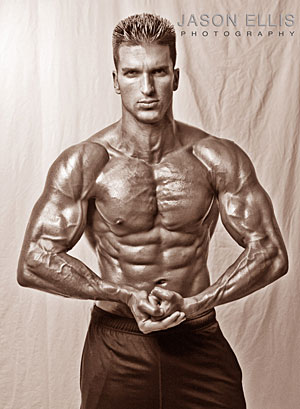 Getting Shredded for a Bodybuilding or Physique Competition – By Vince Del Monte
Getting Shredded for a Bodybuilding or Physique Competition – By Vince Del Monte
I have a lot of people ask me how they should train in order to get impressively shredded for a bodybuilding or physique competition. Most often, it comes from people that are entering their first competition.
Unfortunately, there’s no single answer to that question, because every person’s body is different, and the timeframe can vary by the way their body responds. What I can do, though, is give them some guidelines that they can use to build the method that works well for them.
The thing is, getting shredded is partly science and partly art. The science is knowing how, when and why your body burns fat, what causes spikes in your insulin and cortisol levels and what causes your body to retain or excrete water. The art comes into play in learning exactly how your body responds to the steps in your plan. It can often take several competitions to figure out exactly what your optimal method is.
There are three main areas to concentrate on in order to give your body that shredded look for a bodybuilding or physique competition: caloric deficiency, carb intake and water intake.
Notice that I didn’t say anything about ramping up your weight training prior to the competition. There’s a good reason not to do so. When you’re cutting, your weight training is limited to maintaining the muscle you already have. You’re trying to lower your body fat a couple of points, and you don’t have sufficient nutrition to be building new muscle tissue. The idea of shredding is just to accentuate the definition of your existing muscles.
Identify your Starting Point
You’ve all heard me say plenty of times before that you have to set goals – goals that can be measured. A goal without a deadline is just a dream, not likely to ever come true.
Your deadline will be the date of the event you’re competing in, but you still need to have a goal, and in order to know what body fat level you’re targeting, you really need to know where you’re starting from.
A good rule of thumb when cutting to get shredded for an event is to target a loss of about 1% of your body fat per week. If your body fat is 12% now, you should start working on losing fat about 6 weeks prior. Adding another week isn’t a bad idea, just in case you get thrown off track.
Plan on Some Intense Cardio
Throughout this period, you should be doing some high intensity interval training for your cardio workout, to get into a calorie deficiency mode. Don’t try to create all the deficit with cardio, though, because it’s a lot harder to burn 3500 calories (that’s about 1 pound of fat) per week than it is to cut 3500 calories per week. The ideal approach is to split that between the two, so you’re burning an extra 250 calories, while cutting another 250 calories, each day.
Lower your Carb Intake
A great way to do this is to totally stop your carb intake in the mornings, replacing them with a high protein, no carb breakfast. I got fantastic results using a nut and meat rotation diet for breakfasts, and achieved my all-time low of 4% body fat.
About 6 days before your event, you should cut your carbs back more yet, to anywhere between 0 and 150 grams per day, depending upon your body and your workout schedule. Keep it like that for 2 days, then return to your normal low-carb diet. Then, the last two days before your competition, you’ll went to increase your carb intake.
Regulate your Water Intake
A lot of guys ask me about how to adjust their water intake for shredding muscles, too. This is another factor that depends upon your starting point. I give them a formula, based upon the amount of water they normally consume.
I increase my water intake by 50% about 8 days before my competition. SInce I normally drink around 4 liters per day, that means I jump it to 6 per day. This gets my body accustomed to excreting more water.
Then, about 2 days before my competition, I drop it back to half of what it normally was. In my case, that means 50% of my normal 4 liters per day, or 2 liters. Finally, on the day of competition, I cut it in half again – to 1 liter, in my case.
This will help you shed water, which will help define your muscles. Combined with a lower body fat level and well developed muscles, it’ll give you that head-turning shredded look you’re looking for.
Adjusting your Process
As I already mentioned, you’ll need to vary this process, depending upon your body, its condition and the timeframe you’re dealing with. What works for your buddy might not work nearly as well for you. More importantly, though, what worked for you six months ago might not work well at all, this month.
Remember, your body is changing all the time, not just in condition, but in metabolism. That means you may be at a different starting point, and that your body may respond differently to the same diet and exercise program that worked great last time.
Unfortunately, there really isn’t any perfect program detailing how to get shredded muscles – just general guidelines. You’ll have to experiment a little to fine-tune it to your needs, and be ready to adjust it from one competition to the next, if necessary.
See Also:
Bodybuilding Tips for Women
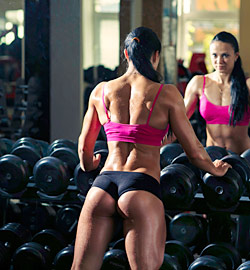
By Julian Brown, BS, ACE-CPT, NASM-FNS
As a personal trainer, I’ve had numerous female clients confused about how they should approach their strength training and nutrition program. There seems to be a plethora of conflicting information out there when it comes to women and bodybuilding.
However, reaching your bodybuilding objectives is achievable for women of all fitness backgrounds. By ditching common misconceptions, training intensely with challenging weights, and eating for function you’ll be able to achieve your bodybuilding goals without all the confusion.
Ditching the Misconceptions
You might have heard lifting heavy weights makes you bulky or look like a man, muscle turns into fat and vice-versa, and exercising your abs, butt, hips, or wherever area will make you lose fat there. Well, I’m here to tell you to forget all that.
Lifting heavy weights will not make you look like a man. First, the term heavy is subjective. What’s heavy and challenging for one person may be another person’s warm up. At what weight would you draw the line? Second, I’ve trained numerous female clients with intense and challenging weights and although it may be subjective to my personal opinion, they still look like women and retained their femininity. Lastly, women simply do not and cannot naturally produce the amount of testosterone needed to bulk up like a man. It is also important to realize that the muscle built through strength training won’t turn into fat if you stop working out.
Contrary to what you may have heard, muscle size would simply regress or get smaller due to the lack of stress if you were to stop exercising. Generally, when avid exercisers stop working out, they don’t adjust their caloric intake accordingly; thus, leaving them in with an excessive amount of calorie consumption because of the lack of energy expenditure previously achieved through activity. This is what usually leads to fat gain. Muscle and fat are two very different tissues and they don’t convert back and forth. Therefore, you don’t have to worry about your muscle turning into fat if you decide to quit exercising.
Exercising a muscle group will help you strengthen, tone, and build that muscle, but it has very little to do with where you lose fat. The body generally loses weight all-over when you expend more calories than you consume. In other words, you really can’t control where you lose the weight so the best way to lose fat in a specific area is to create a caloric deficiency and to continue to lose fat all over until you’re happy with your problem areas.
Now, that we’ve ditched some of the common misconceptions associated with women and weight training, let’s talk about how to reach your goals.
Training with Challenging Weights
At the cellular level, men and women’s muscles are exactly the same. The big difference is the amount of hormones (testosterone and estrogen) acting upon the muscles. According to Bill Kreamer in the Essentials of Strength Training and Conditioning, women have about 15 to 20 times less testosterone than men (2008). This is the very reason lifting intensely with challenging weights won’t make a women look like a man. Too often, the fear of looking like a professional women’s bodybuilder, whom generally abuse synthetic testosterone (steroids) in high amounts, make women shy away from challenging weights. However, women who train with intense and challenging weights end up with a firm, athletic, slender, and fit look because muscle takes up significantly less volume than fat. If you’re not as slender and tone as you want, chances are it’s because of a faulty or high calorie diet. This is why’s its critical to have a nutrition plan that supports your goals.
Eating for Function
For this section, I want you to think of your body as a bank account. When you’re in a caloric deficiency, it’s like spending more money than you make which is great for weight loss. However, if you continue to spend more money than you make, eventually you’ll max out your credit cards and run out of cash flow. When this happens your weight loss progress will stall. For this reason, whenever you’re in a caloric deficient state it’s critical to include a re-feed day weekly or in some cases twice a week. Think of your re-feed days as paying off your credit card debits. Thus, allowing you to continue to keep spending, or in this case continue to burn fat (Learn more about re-feeds here).
If you’re happy with where you’re at and you simply wish to maintain your figure, then you want to be sure to be consuming an adequate amount of calories for your activity. Think of this as balancing your budget. You’re spending just as much money as you’re bringing in.
Finally, if you want to put on weight you’ll need to consume more calories than you burn, or what’s referred to as being in a caloric surplus state. In this case, it’s like bringing in more money than you spend. You’ll have a surplus of cash flow in your bank account allowing you to pay in full for the items you want (muscle), or in some cases items you may not want (fat).
Whatever your goals are, you need to make sure you’re spending and saving wisely in order to provide your body with the right amount of calories. This will help ensure that you reach your goals.
There’s an overabundance of contradictory women’s bodybuilding information in the fitness world, but by ditching common misconceptions, training intensely with challenging weights, and eating for function, you’ll be able to successfully reach your bodybuilding goals without all the confusion.
References
- National Strength and Conditioning Association (2008). Essentials of Strength Training and Conditioning, 3rd ed., Champaign, IL: Human Kinetics.
Four Common Women’s Bodybuilding Myths
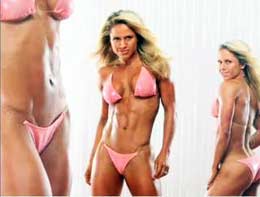
Ever questioned the whole issue of women and bodybuilding? More and more women are starting to get involved in the activity of weight lifting but often shy away from anything perceived to be women’s bodybuilding as they just don’t think this is the look they’re trying to create or they are afraid that they are going to get bulky. The truth is, this is far from the case.
The fear of getting bulky will often make women slow their routines or use small weights, thus decreasing the results they get from working out.
By clearing up some of the biggest myths surrounding women’s bodybuilding, you can get it straight in your mind what all weight lifting has to offer and help clearly see why this is an activity you must be working hard at.
Let’s take a look at some of the top women’s bodybuilding myths so we can clear things up for you.
#1. Women Will easily Build Gigantic Muscles
The first of the women and bodybuilding myths that tends to float around is that as soon as you start ‘bodybuilding’ or doing any type of weight lifting activity, you will start to develop large bulky muscles.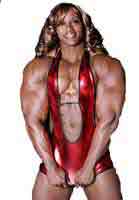
This, however, couldn’t be furthest from the truth. What you should know here is that any women who you do see who have larger muscles have spent years of their life working incredibly hard to build this up and have used very high calorie diets in order to do so.
If you look at the average woman who’s going to the gym three to four times per week and if anything is using a lower calorie diet, this just isn’t going to happen.
Plus, females naturally do not have the testosterone levels in their body, which is the primary muscle building hormone that males have to a large degree to develop this type of size.
Those women who are abnormally large and very muscular are often supplementing with testosterone in order to achieve this – something that you obviously aren’t going to do.
#2. Women Will Lose Breast Tissue
The second of the bodybuilding and women myths that must be cleared up is that if you start weight lifting, you will lose your breast tissue.
What you must know here is the fact that breast tissue is largely fat mass. So, what really causes breast tissue to be lost is a decrease in body fat, not the fact that you’re working the muscles underneath the fat.
In fact, doing chest exercises regularly will help to boost your cleavage, so if anything you look better. It’s only when you go on an intense diet and aim to get down to very lean body fat levels that you’ll start to notice your breast shape and fullness changing.
#3. Face Shape May Change
Moving on, another women’s bodybuilding myth to know about is regarding the thinking that your face structure may change. Many females look at the women in bodybuilding and note that their face does look different and definitely decide they don’t want this for themselves.
Here, remember that how your face looks does change as you lose lots of body fat – again, fatty tissue is stored in the face so very lean individuals will look more gaunt-like, but then also note that those females who have hard jaw lines are also the same ones adding extra testosterone to their body.
This will cause them to take on many male traits, hence why you see the change taking place. This again is not something that you need to worry about.
#4. Built Muscle Will Turn To Fat
Finally, the last bodybuilding myth all you ladies should know about is the myth that after you build muscle, if you stop weight lifting it will turn to body fat. This couldn’t be furthest from the truth. You cannot change one tissue to another form of tissue so just like you can’t convert fat to muscle, you won’t convert muscle to fat.
In fact, your muscle mass will help to prevent fat gain because it will cause your metabolism to be higher overall.
What will occur if you stop weight training is you may begin to lose lean muscle mass and as you do your metabolism may slow down, so this occurrence could be what causes you to start to see fat gains. Muscle will never be converted directly into fat mass, however.
The Bottom Line
Hopefully by reading through these women’s bodybuilding myths you have come to realize that building muscle will only boost your progress and keep you leaner, rather than becoming more fearful of picking up those weights and performing this activity.
Bodybuilding Tips For Baby Boomers
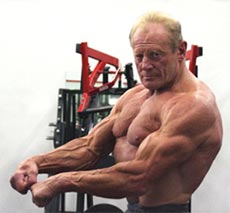 By Julian Brown, BS, ACE-CPT, NASM-FNS
By Julian Brown, BS, ACE-CPT, NASM-FNS
Although everyone should be striving to train smarter instead of harder, this approach becomes increasingly more important as we age.
During the aging process, joints deteriorate, hormone levels decline, and the body’s metabolism naturally slows. However, don’t let these issues stand in your way of reaching your bodybuilding goals.
By weight training with periodization and less volume, maintaining proper form, and allocating sufficient recovery time you’ll be able to still reach your goals without letting age get in the way.
Weight Training with Periodization and Less Volume
Muscle is metabolic currency. Thus, meaning the more muscle you have the faster your metabolism, or the more calories you burn at rest. How do you effectively build muscle? According to the size principle, the smaller, slow-twitch muscle fibers are recruited first. Progressively larger, fast-twitch muscle fibers are recruited based on the increasing demands of heavier weights.
Therefore, meaning heavier weights (that which you can lift for less than 6 reps) require the recruitment of more muscle fibers than lighter weights (that which you can lift for 12 or more reps). However, as you may have already suspected, heavy weights cause more stress on the joints and connective tissues which makes not only form, but periodization increasingly more important as you age.
Periodization allows us to train at a high intensity or volume with alternating periods of lower intensity or volume to facilitate recovery and to maximize performance. According to a study published in Journal of Strength and Conditioning Research, periodized programs result in greater strength (1 Rep Max) gains than non-periodized multi-set and single-set programs.
As you get older, I recommend that you cut down on the frequency of your heavy weight training sessions for better recovery and for less stress on the connective tissues. Also, if you haven’t already been working out with heavy weights, you’ll need to go through the initial conditioning phase first. No one, not even the youthful, should jump straight into a heavy weight lifting program without adequately allowing the body time to adjust. In addition to periodization, your routine should also include less volume (total exercises and sets) than it did when you were younger. Because recovery is an issue with age, using less volume will allow you to better recover from your intense workouts and will allow you to train more often.
Proper Form
As you age, joints and connective tissues naturally begin to deteriorate. Supplementing with glucosamine and chondroitin may help alleviate some pain and deterioration, but maintaining proper form in the weight room is critical when it comes to protecting your joints. Because using bad form such as bouncing, jerking, or hurling with heavy resistance can potentially cause a damaging amount of stress to your connective tissues, you need to be sure to maintain proper form at all times.
Proper form ensures the muscles you’re working receive full stress from the exercise performed, and your body is positioned in such a way that your muscles and joints are in the strongest position possible, thereby reducing the risk of training injuries. As we age, it becomes increasingly harder to recover from training injuries so preventing them from happening in the first place is ideal. To help maintain proper form during your workout, try exercising in front of the mirror for self correction, training with an experienced workout partner, or hiring a certified personal trainer.
Sufficient Recovery Time
As our bodies age, they become less efficient at repairing/rebuilding damaged tissues partially due to the natural decline of our hormonal levels. This makes the recovery stage an extremely important aspect to your strength training program. During the recovery stage, the body repairs, rebuilds, and strengthens itself.
However, recovery is one of the most over-looked parts to a strength training program and without sufficient time to repair and replenish, the body will continue to breakdown from intensive exercise increasing your risk for overuse injuries. As you get older and depending on the volume and intensity of your training, your muscles could take roughly anywhere between 48 – 96 hours to recover so make sure to listen to your body and don’t over-due it.
Getting older may affect certain aspects of your exercise training program, but it doesn’t mean you can’t reach your goals. By training smarter instead of harder you can still achieve your bodybuilding goals regardless of age.
Bodybuilding for Baby Boomers: References
- Fitness: The Complete Guide;” International Sports Sciences Association; 2007
- Journal of Strength and Conditioning Research ,2009 Dec;23(9):2437-42
About Julian Brown
JulianBrownTraining.com Julian is the co-owner of The Yard Fitness, an established fitness writer, a professional natural bodybuilder, a fitness & sport nutrition specialist, and a certified personal trainer. He began strength training at the young age of fourteen to improve his sports performance and hasn’t looked back since. Julian is a graduate of Grambling State University, ACE & NASM certified, and he has over a decade of personal experience in strength training.

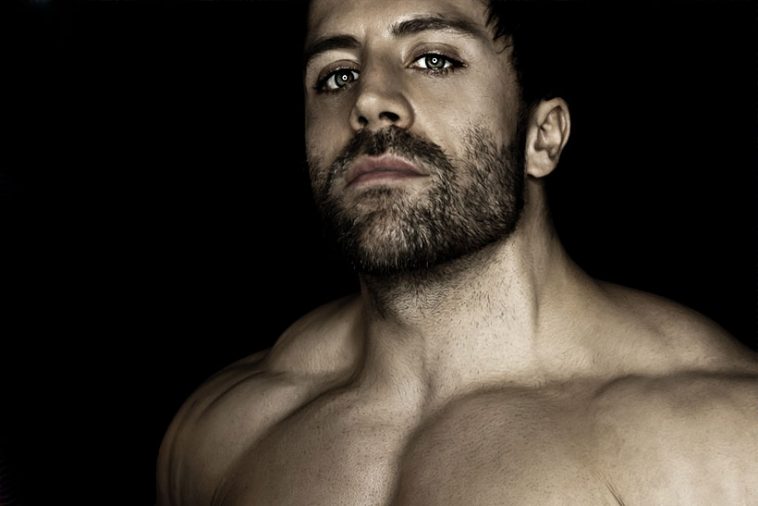
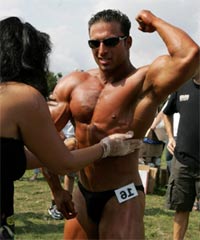 Bodybuilding 101
Bodybuilding 101